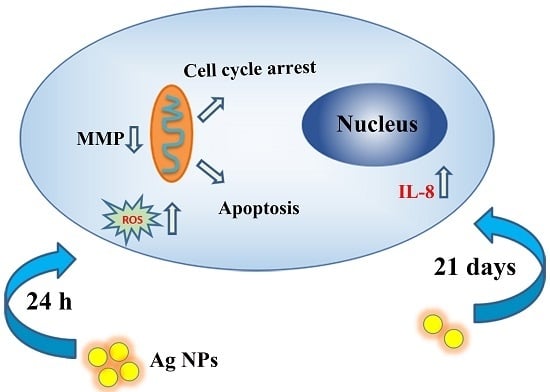Toxicological Effects of Caco-2 Cells Following Short-Term and Long-Term Exposure to Ag Nanoparticles
Abstract
:1. Introduction
2. Results
2.1. Characterization of Ag NPs
2.2. Cytotoxicity of Ag NPs after the Short-Term Exposure to Ag NPs
2.3. Apoptosis of Caco-2 Cells after the Short-Term Exposure to Ag NPs
2.4. MMP and ROS Assays of Caco-2 Cells after the Short-Term Exposure to Ag NPs
2.5. Cell Cycle Assay of Caco-2 Cells after the Short-Term Exposure to Ag NPs
2.6. Cytokine IL-8 Secretion of Caco-2 Cells after the Short-Term Exposure to Ag NPs
2.7. Proliferation of Caco-2 Cells after the Long-Term Exposure to Ag NPs
2.8. Viability and Membrane Integrity of Caco-2 Cells after the Long-Term Exposure to Ag NPs
2.9. Live/Dead Staining of Caco-2 Cells after the Long-Term Exposure to Ag NPs
2.10. Nucleus Changes of Caco-2 Cells after the Long-Term Exposure to Ag NPs
2.11. Cytokine IL-8 Secretion of Caco-2 Cells after the Long-Term Exposure to Ag NPs
3. Discussion
4. Experimental Section
4.1. Ag NPs and Their Physicochemical Characterization
4.2. Cell Lines and Cell Culture
4.3. Viability and Membrane Integrity of Caco-2 Cells after the Short-Term Exposure to Ag NPs
4.4. Live/Dead Staining of Caco-2 Cells after the Short-Term Exposure to Ag NPs
4.5. Apoptosis Analysis of Caco-2 Cells after the Short-Term Exposure to Ag NPs
4.6. Measurement of the Mitochondrial Membrane Potential (MMP) of Caco-2 Cells after the Short-Term Exposure to Ag NPs
4.7. Measurement of Intracellular ROS of Caco-2 Cells after the Short-Term Exposure to Ag NPs
4.8. Cell Cycle Analysis of Caco-2 Cells after the Short-Term Exposure to Ag NPs
4.9. Cytokine IL-8 Secretion of Caco-2 Cells after the Short-Term Exposure to Ag NPs
4.10. Proliferation of Caco-2 Cells after the Long-Term Exposure to Ag NPs
4.11. Viability, Membrane Integrity, and Live/Dead Cell Staining Assays of Caco-2 Cells after the Long-Term Exposure to Ag NPs
4.12. Nuclei Staining of Caco-2 Cells after the Long-Term Exposure to Ag NPs
4.13. Cytokine IL-8 Secretion of Caco-2 Cells after the Long-Term Exposure to Ag NPs
4.14. Statistical Analysis
5. Conclusions
Supplementary Materials
Acknowledgments
Author Contributions
Conflicts of Interest
References
- Nowack, B.; Krug, H.F.; Height, M. 120 years of nanosilver history: Implications for policy makers. Environ. Sci. Technol. 2011, 45, 1177–1183. [Google Scholar] [CrossRef] [PubMed]
- Matzke, M.; Jurkschat, K.; Backhaus, T. Toxicity of differently sized and coated silver nanoparticles to the bacterium Pseudomonas putida: Risks for the aquatic environment? Ecotoxicology 2014, 23, 818–829. [Google Scholar] [CrossRef] [PubMed]
- Hendren, C.O.; Mesnard, X.; Droge, J.; Wiesner, M.R. Estimating production data for five engineered nanomaterials as a basis for exposure assessment. Environ. Sci. Technol. 2011, 45, 2562–2569. [Google Scholar] [CrossRef] [PubMed]
- Quadros, M.E.; Marr, L.C. Environmental and human health risks of aerosolized silver nanoparticles. J. Air Waste Manag. Assoc. 2010, 60, 770–781. [Google Scholar] [CrossRef] [PubMed]
- Kreyling, W.G.; Semmler-Behnke, M.; Takenaka, S.; Moller, W. Differences in the biokinetics of inhaled nano-versus micrometer-sized particles. Acc. Chem. Res. 2013, 46, 714–722. [Google Scholar] [CrossRef] [PubMed]
- Jiang, X.; Miclaus, T.; Wang, L.; Foldbjerg, R.; Sutherland, D.S.; Autrup, H.; Chen, C.; Beer, C. Fast intracellular dissolution and persistent cellular uptake of silver nanoparticles in CHO-K1 cells: Implication for cytotoxicity. Nanotoxicology 2015, 9, 181–189. [Google Scholar] [CrossRef] [PubMed]
- Kim, Y.-J.; Yang, S.I.; Ryu, J.-C. Cytotoxicity and genotoxicity of nano-silver in mammalian cell lines. Mol. Cell Toxicol. 2010, 6, 119–125. [Google Scholar] [CrossRef]
- Hamilton, R.F., Jr.; Buckingham, S.; Holian, A. The effect of size on Ag nanosphere toxicity in macrophage cell models and lung epithelial cell lines is dependent on particle dissolution. Int. J. Mol. Sci. 2014, 15, 6815–6830. [Google Scholar] [CrossRef] [PubMed]
- Dubey, P.; Matai, I.; Kumar, S.U.; Sachdev, A.; Bhushan, B.; Gopinath, P. Perturbation of cellular mechanistic system by silver nanoparticle toxicity: Cytotoxic, genotoxic and epigenetic potentials. Adv. Colloid Interface Sci. 2015, 221, 4–21. [Google Scholar] [CrossRef] [PubMed]
- Song, Y.J.; Guan, R.; Lyu, F.; Kang, T.; Wu, Y.; Chen, X. In vitro cytotoxicity of silver nanoparticles and zinc oxide nanoparticles to human epithelial colorectal adenocarcinoma (Caco-2) cells. Mutat. Res. Fund. Mol. Mech. 2014, 769, 113–118. [Google Scholar] [CrossRef] [PubMed]
- Aueviriyavit, S.; Phummiratch, D.; Maniratanachote, R. Mechanistic study on the biological effects of silver and gold nanoparticles in Caco-2 cells–Induction of the Nrf2/HO-1 pathway by high concentrations of silver nanoparticles. Toxicol. Lett. 2014, 224, 73–83. [Google Scholar] [CrossRef] [PubMed]
- Cheung, T.S.; Lau, P.M.; Lu, H.; Ho, H.P.; Lui, P.P.Y.; Kong, S.K. Cytotoxic and sublethal effects of silver nanoparticles on tendon-derived stem cells—Implications for tendon engineering. Toxicol. Res. 2016, 5, 318–330. [Google Scholar] [CrossRef]
- Comfort, K.K.; Braydich-Stolle, L.K.; Maurer, E.I.; Hussain, S.M. Less is more: Long-term in vitro exposure to low levels of silver nanoparticles provides new insights for nanomaterial evaluation. ACS Nano 2014, 8, 3260–3271. [Google Scholar] [CrossRef] [PubMed]
- Coccini, T.; Manzo, L.; Bellotti, V.; Simone, U.D. Assessment of cellular responses after short- and long-term exposure to silver nanoparticles in human neuroblastoma (SH-SY5Y) and astrocytoma (D384) cells. Sci. World J. 2014, 259765. [Google Scholar] [CrossRef] [PubMed]
- Vales, G.; Rubio, L.; Marcos, R. Long-term exposures to low doses of titanium dioxide nanoparticles induce cell transformation, but not genotoxic damage in BEAS-2B cells. Nanotoxicology 2015, 9, 568–578. [Google Scholar] [CrossRef] [PubMed]
- Aude-Garcia, C.; Villiers, F.; Collin-Faure, V.; Pernet-Gallay, K.; Jouneau, P.-H.; Sorieul, S.; Mure, G.; Gerdil, A.; Herlin-Boime, N.; Carrière, M.; et al. Different in vitro exposure regimens of murine primary macrophages to silver nanoparticles induce different fates of nanoparticles and different toxicological and functional consequences. Nanotoxicology 2016, 10, 586–596. [Google Scholar] [CrossRef] [PubMed]
- Hristozov, D.R.; Gottardo, S.; Critto, A.; Marcomini, A. Risk assessment of engineered nanomaterials: A review of available data and approaches from a regulatory perspective. Nanotoxicology 2012, 6, 880–898. [Google Scholar] [CrossRef] [PubMed]
- Tarantini, A.; Lanceleur, R.; Mourot, A.; Lavault, M.-T.; Casterou, G.; Jarry, G.; Hogeveen, K.; Fessard, V. Toxicity, genotoxicity and proinflammatory effects of amorphous nanosilica in the human intestinal Caco-2 cell line. Toxicol. Vitr. 2015, 29, 398–407. [Google Scholar] [CrossRef] [PubMed]
- Gerloff, K.; Fenoglio, I.; Carella, E.; Kolling, J.; Albrecht, C.; Boots, A.W.; Förster, I.; Schins, R.P.F. Distinctive toxicity of TiO2 rutile/anatase mixed phase nanoparticles on Caco-2 cells. Chem. Res. Toxicol. 2012, 25, 646–655. [Google Scholar] [CrossRef] [PubMed]
- Chalew, A.T.E.; Schwab, K.J. Toxicity of commercially available engineered nanoparticles to Caco-2 and SW480 human intestinal epithelial cells. Cell Biol. Toxicol. 2013, 29, 101–116. [Google Scholar] [CrossRef] [PubMed]
- Miethling-Graff, R.; Rumpker, R.; Richter, M.; Verano-Braga, T.; Kjeldsen, F.; Brewer, J.; Hoyland, J.; Rubahn, H.-G.; Erdmann, H. Exposure to silver nanoparticles induces size- and dose-dependent oxidative stress and cytotoxicity in human colon carcinoma cells. Toxicol. Vitr. 2014, 28, 1280–1289. [Google Scholar] [CrossRef] [PubMed]
- Foldbjerg, R.; Jiang, X.; Miclaus, T.; Chen, C.; Autrup, H.; Beer, C. Silver nanoparticles—Wolves in sheep’s clothing? Toxicol. Res. 2015, 4, 563–575. [Google Scholar] [CrossRef]
- Liang, J.; Zeng, F.; Zhang, M.; Pan, Z.; Chen, Y.; Zeng, Y.; Xu, Y.; Xu, Q.; Huang, Y. Green synthesis of hyaluronic acid-based silver nanoparticles and their enhanced delivery to CD44+ cancer cells. RSC Adv. 2015, 5, 43733–43740. [Google Scholar] [CrossRef]
- Zhang, B.; Bian, W.; Pal, A.; He, Y. Macrophage apoptosis induced by aqueous C60 aggregates changing the mitochondrial membrane potential. Environ. Toxicol. Pharm. 2015, 39, 237–246. [Google Scholar] [CrossRef] [PubMed]
- Kocbek, P.; Teskac, K.; Kreft, M.E.; Kristl, J. Toxicological aspects of long-term treatment of keratinocytes with ZnO and TiO2 nanoparticles. Small 2010, 6, 1908–1917. [Google Scholar] [CrossRef] [PubMed]
- Wang, J.; Sun, P.; Bao, Y.; Liu, J.; An, L. Cytotoxicity of single-walled carbon nanotubes on PC12 cells. Toxicol. Vitr. 2011, 25, 242–250. [Google Scholar] [CrossRef] [PubMed]
- ISO 10993–5:2009. Biological Evaluation of Medical Devices—Part 5: Tests for in Vitro Cytotoxicity. Standardization IOf ed. vol. ISO 10993–5. Switzerland; 2009. Available online: http://www.instrument.com.cn/download/shtml/436871.shtml (accessed on 8 May 2016).
- The Woodrow Wilson Inventory. Available online: http://www.nanotechproject.org (accessed on 12 February 2016).
- Ahameda, M.; Karnsa, M.; Goodsona, M.; Rowea, J.; Hussainb, S.M.; Schlagerb, J.J.; Honga, Y. DNA damage response to different surface chemistry of silver nanoparticles in mammalian cells. Toxicol. Appl. Pharm. 2008, 233, 404–410. [Google Scholar] [CrossRef] [PubMed]
- Yang, C.; Uertz, J.; Yohan, D.; Chithrani, B.D. Peptide modified gold nanoparticles for improved cellular uptake, nuclear transport, and intracellular retention. Nanoscale 2014, 6, 12026–12033. [Google Scholar] [CrossRef] [PubMed]
- Gliga, A.R.; Skoglund, S.; Wallinder, I.O.; Fadeel, B.; Karlsson, H.L. Size-dependent cytotoxicity of silver nanoparticles in human lung cells: The role of cellular uptake, agglomeration and Ag release. Part. Fibre Toxicol. 2014, 11, 11. [Google Scholar] [CrossRef] [PubMed]
- Wei, L.; Lu, J.; Xu, H.; Patel, A.; Chen, Z.-S.; Chen, G. Silver nanoparticles: Synthesis, properties, and therapeutic applications. Drug Discov. Today 2015, 20, 595–601. [Google Scholar] [CrossRef] [PubMed]
- Böhmert, L.; Niemann, B.; Thünemann, A.F.; Lampen, A. Cytotoxicity of peptide-coated silver nanoparticles on the human intestinal cell line Caco-2. Arch. Toxicol. 2012, 86, 1107–1115. [Google Scholar] [CrossRef] [PubMed]
- Mtirosyan, A.; Bazes, A.; Schneider, Y.J. In vitro toxicity assessment of silver nanoparticles in the presence of phenolic compounds–preventive agents against the harmful effect? Nanotoxicology 2014, 8, 573–582. [Google Scholar] [CrossRef] [PubMed]
- Stensberg, M.C.; Wei, Q.; McLamore, E.S.; Porterfield, D.M.; Wei, A.; Sepúlveda, M.S. Toxicological studies on silver nanoparticles: Challenges and opportunities in assessment, monitoring and imaging. Nanomedicine 2011, 6, 879–898. [Google Scholar] [CrossRef] [PubMed]
- Kim, S.; Choi, J.E.; Choi, J.; Chung, K.-H.; Park, K.; Yi, J.; Ryua, D.-Y. Oxidative stress-dependent toxicity of silver nanoparticles in human hepatoma cells. Toxicol. Vitr. 2009, 23, 1076–1084. [Google Scholar] [CrossRef] [PubMed]
- Vlahopoulos, S.; Boldogh, I.; Casola, A.; Brasier, A.R. Nuclear factor-κB–dependent induction of interleukin-8 gene expression by tumor necrosis factor α: Evidence for an antioxidant sensitive activating pathway distinct from nuclear translocation. Blood 1999, 94, 1878–1889. [Google Scholar] [PubMed]
- Xu, Y.; Tang, H.; Wang, H.; Liu, Y. Blockade of oral tolerance to ovalbumin in mice by silver nanoparticles. Nanomedicine 2015, 10, 419–431. [Google Scholar] [CrossRef] [PubMed]
- Song, Z.-M.; Chen, N.; Liu, J.-H.; Tang, H.; Deng, X.; Xi, W.-S.; Han, K.; Cao, A.; Liu, Y.; Wang, H. Biological effect of food additive titanium dioxide nanoparticles on intestine: An in vitro study. J. Appl. Toxicol. 2015, 35, 1169–1178. [Google Scholar] [CrossRef] [PubMed]



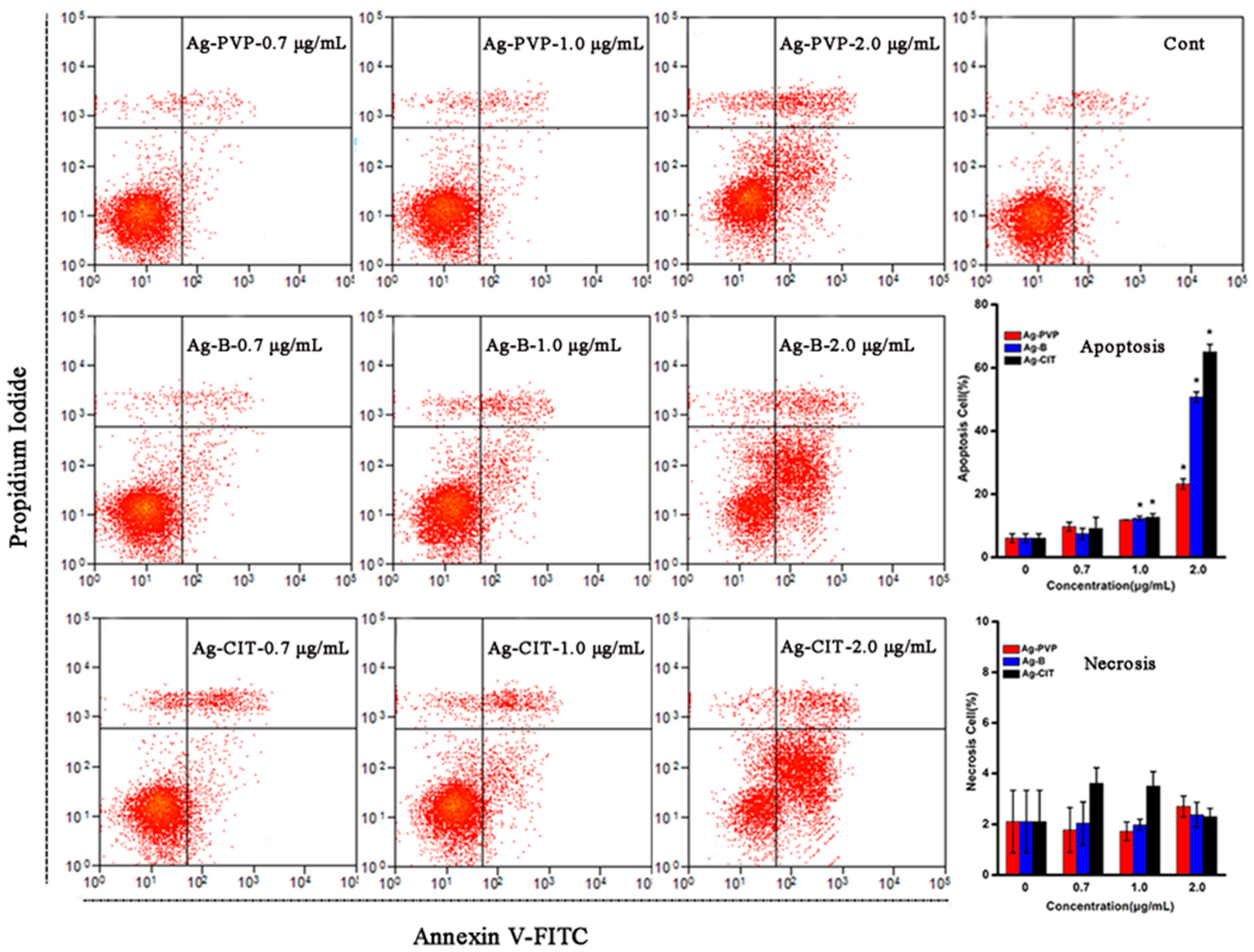


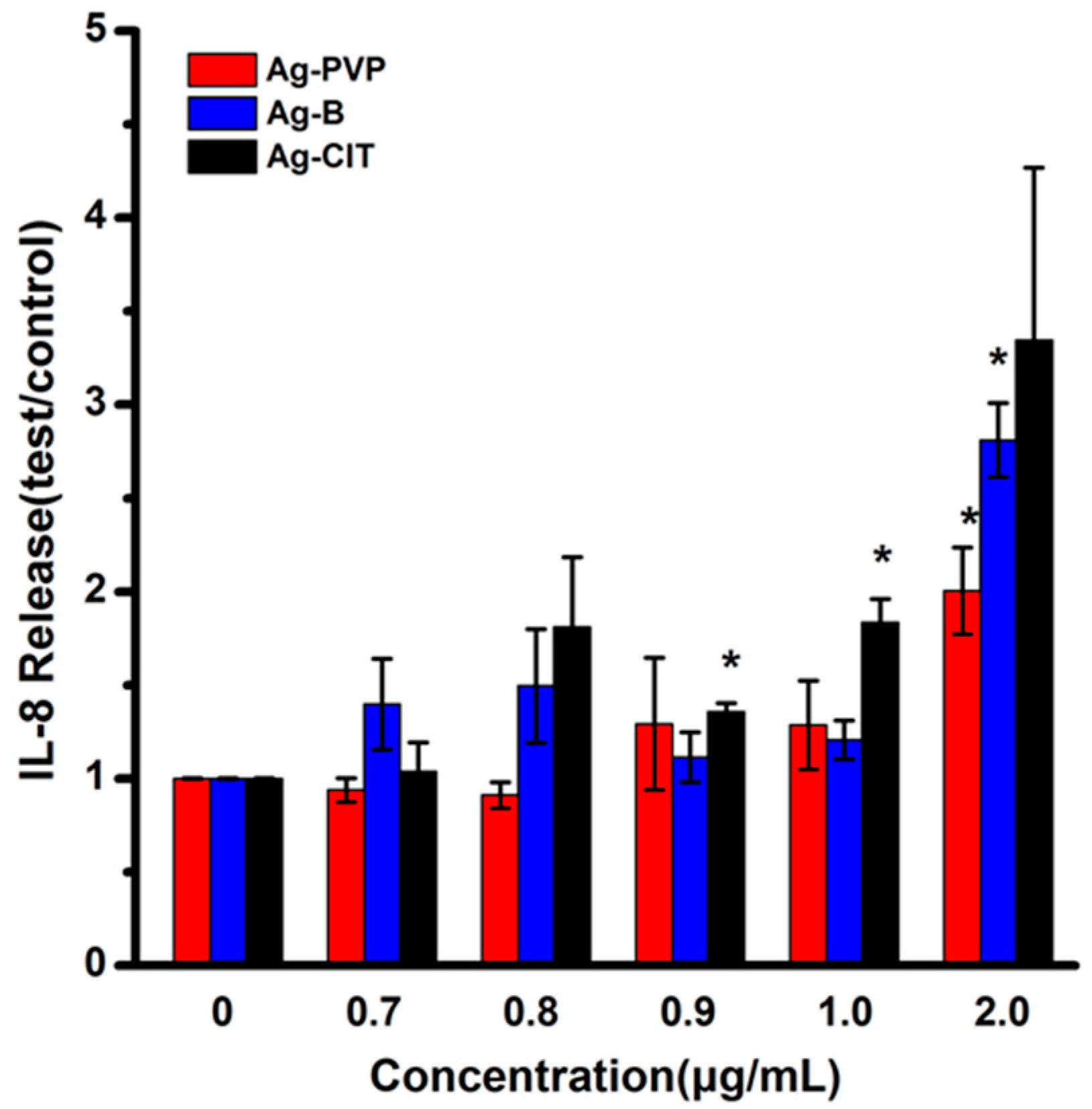



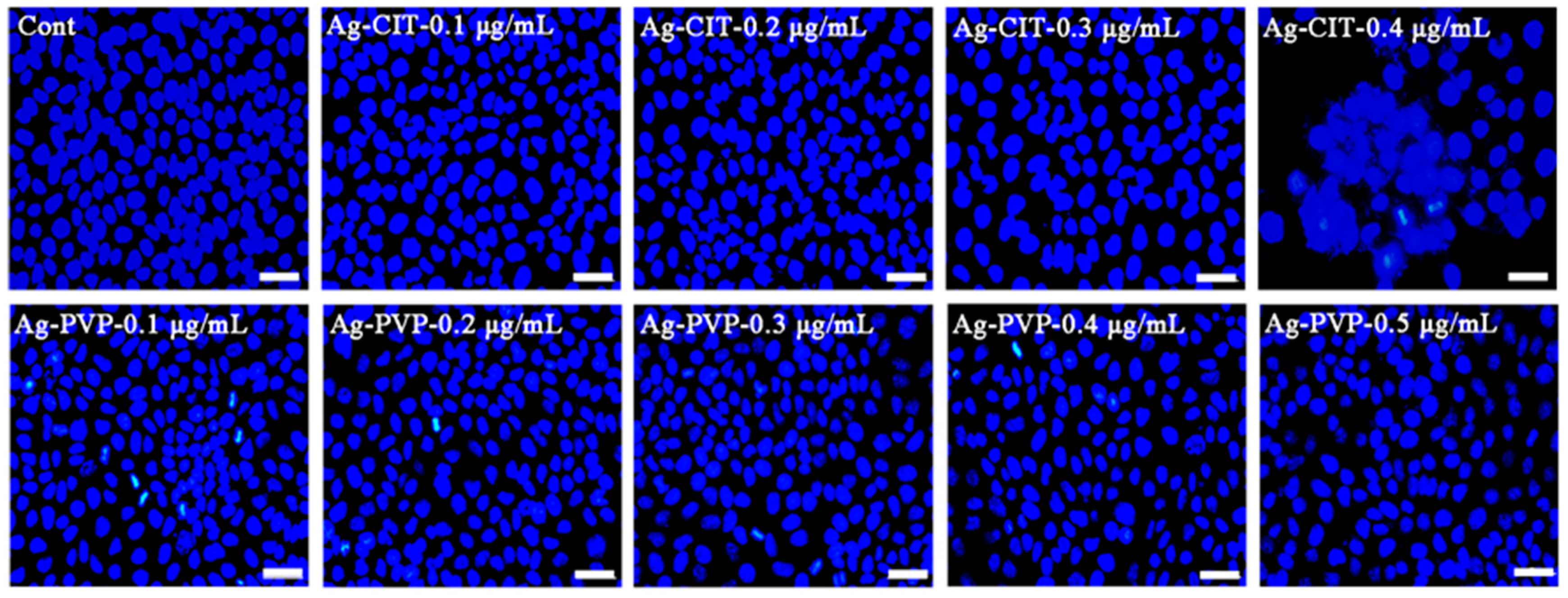
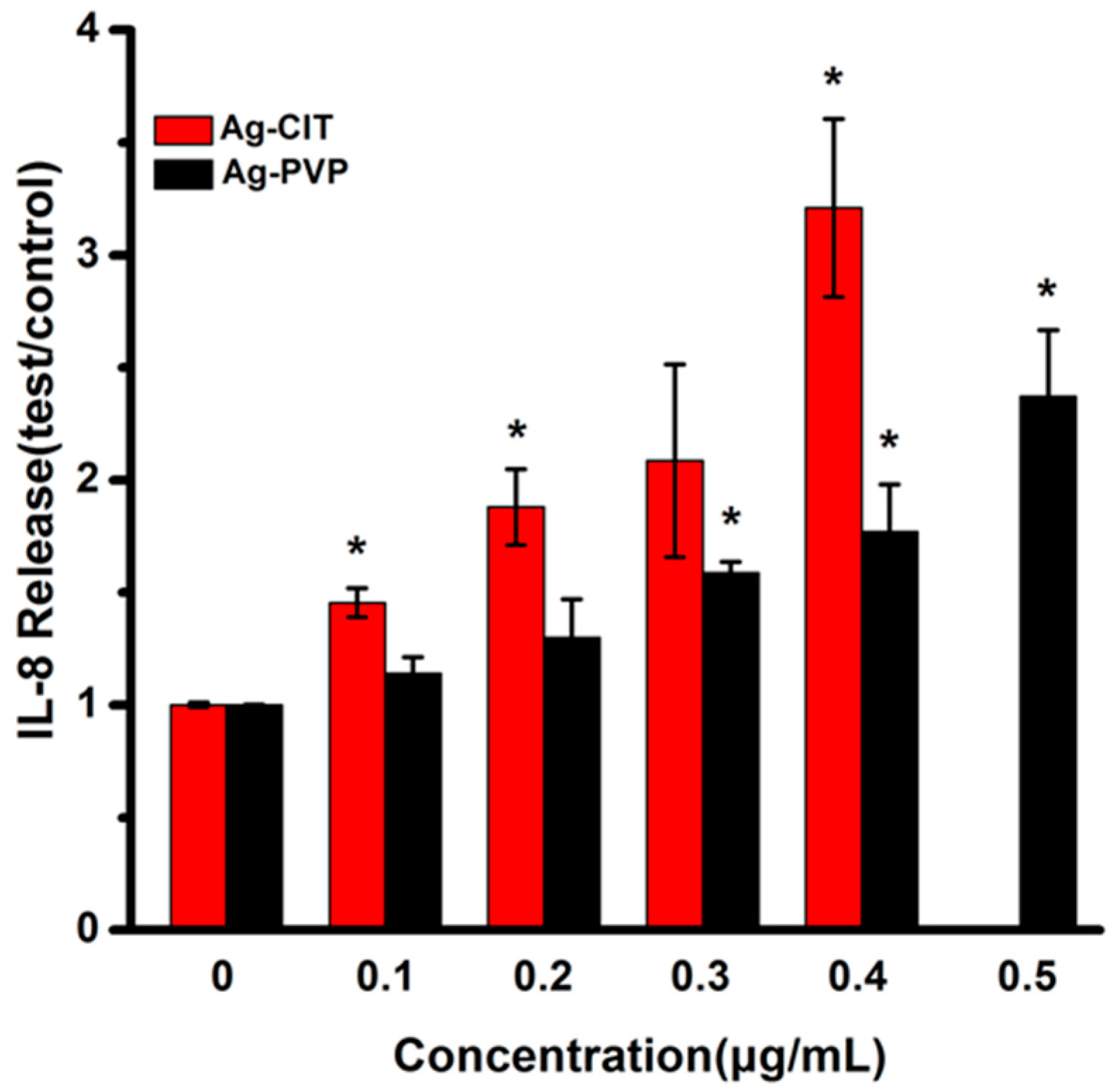
| Sample | Time (h) | Ag-B | Ag-CIT | Ag-PVP | |||
|---|---|---|---|---|---|---|---|
| Conditions | DLS (nm) | ζ-potential (mV) | DLS (nm) | ζ-potential (mV) | DLS (nm) | ζ-potential (mV) | |
| Ultrapure water (Milli Q) | 0 | 58 ± 0.5 | −12.5 ± 0.6 | 58 ± 0.5 | −5.2 ± 0.4 | 79 ± 0.5 | −16.2 ± 0.4 |
| 24 | 58 ± 2.2 | −13.2 ± 0.3 | 57 ± 1.0 | −15 ± 3.2 | 81 ± 0.4 | −14 ± 1.1 | |
| DMEM, 10% FBS | 0 | 50 ± 0.1 | −6.2 ± 1.8 | 51 ± 0.9 | −7.7 ± 1.9 | 70 ± 0.6 | −3.4 ± 1.3 |
| 24 | 62 ± 2.0 | −7.7 ± 1.4 | 54 ± 0.3 | −9.6 ± 1.5 | 63 ± 0.1 | −8.4 ± 0.7 | |
| 48 | 137 ± 5.7 | −8.8 ± 0.4 | 138 ± 20 | −10.4 ± 1.0 | 93 ± 2.1 | −9.2 ± 0.6 | |
© 2016 by the authors; licensee MDPI, Basel, Switzerland. This article is an open access article distributed under the terms and conditions of the Creative Commons Attribution (CC-BY) license (http://creativecommons.org/licenses/by/4.0/).
Share and Cite
Chen, N.; Song, Z.-M.; Tang, H.; Xi, W.-S.; Cao, A.; Liu, Y.; Wang, H. Toxicological Effects of Caco-2 Cells Following Short-Term and Long-Term Exposure to Ag Nanoparticles. Int. J. Mol. Sci. 2016, 17, 974. https://0-doi-org.brum.beds.ac.uk/10.3390/ijms17060974
Chen N, Song Z-M, Tang H, Xi W-S, Cao A, Liu Y, Wang H. Toxicological Effects of Caco-2 Cells Following Short-Term and Long-Term Exposure to Ag Nanoparticles. International Journal of Molecular Sciences. 2016; 17(6):974. https://0-doi-org.brum.beds.ac.uk/10.3390/ijms17060974
Chicago/Turabian StyleChen, Ni, Zheng-Mei Song, Huan Tang, Wen-Song Xi, Aoneng Cao, Yuanfang Liu, and Haifang Wang. 2016. "Toxicological Effects of Caco-2 Cells Following Short-Term and Long-Term Exposure to Ag Nanoparticles" International Journal of Molecular Sciences 17, no. 6: 974. https://0-doi-org.brum.beds.ac.uk/10.3390/ijms17060974





